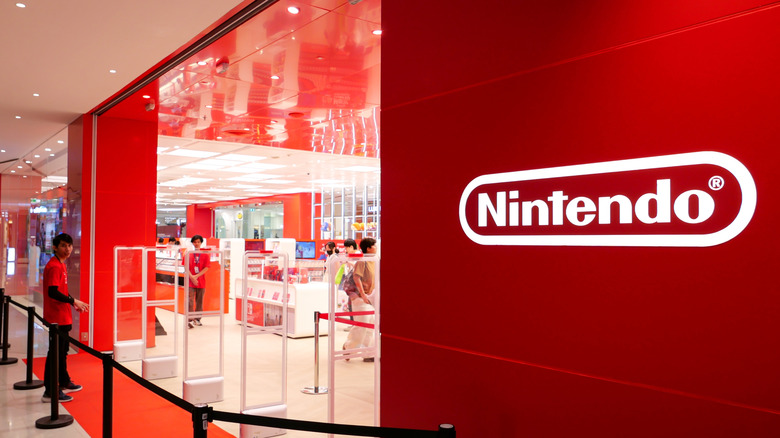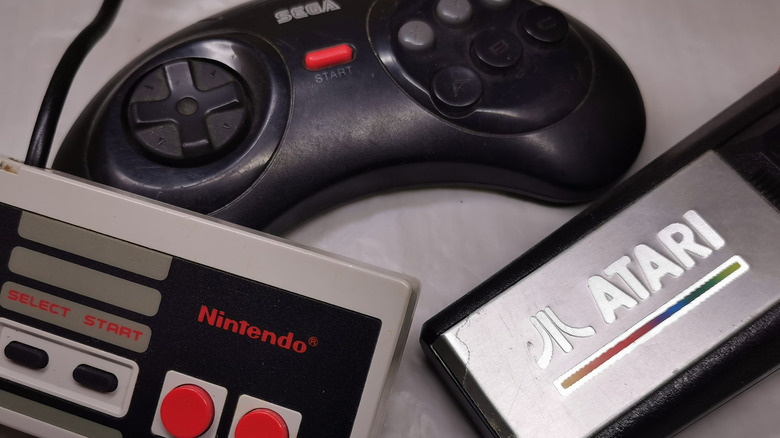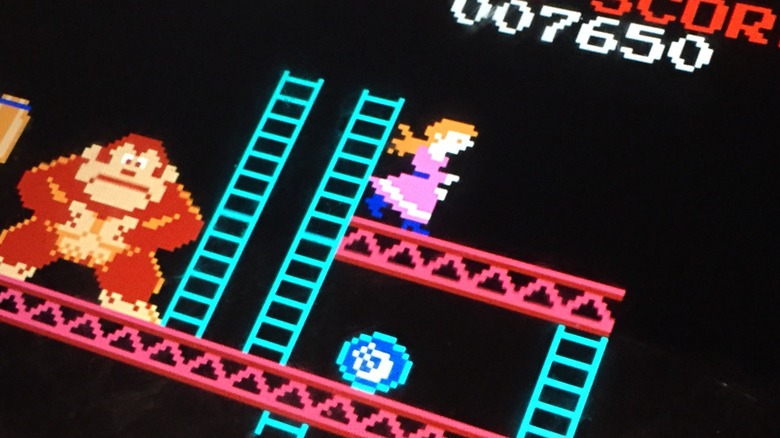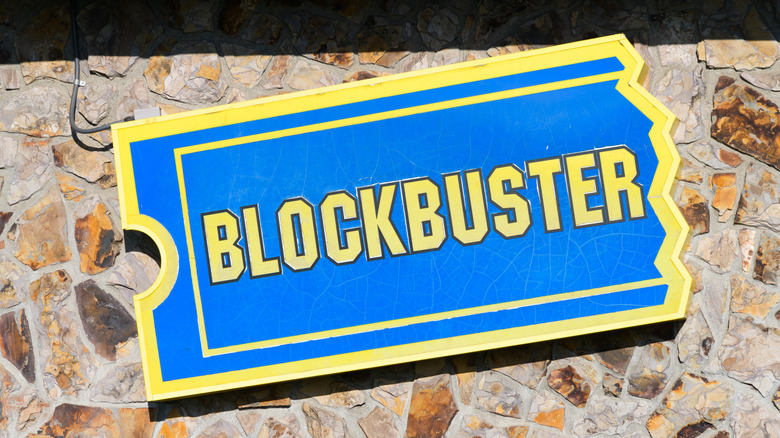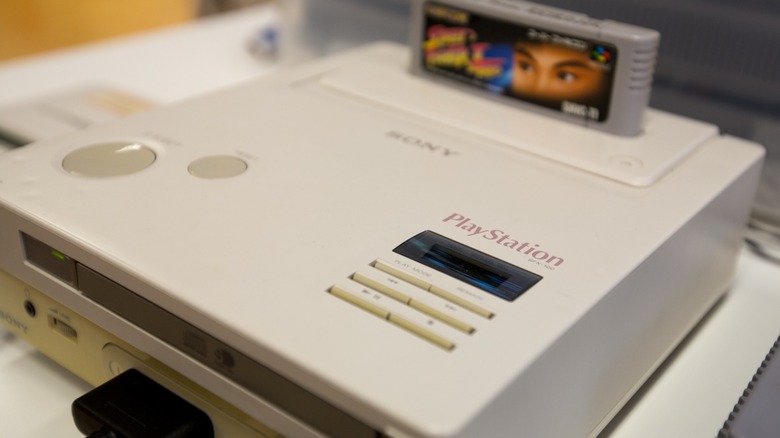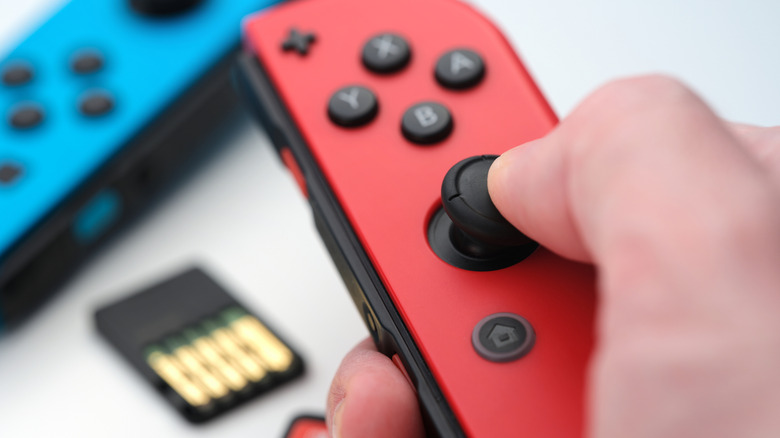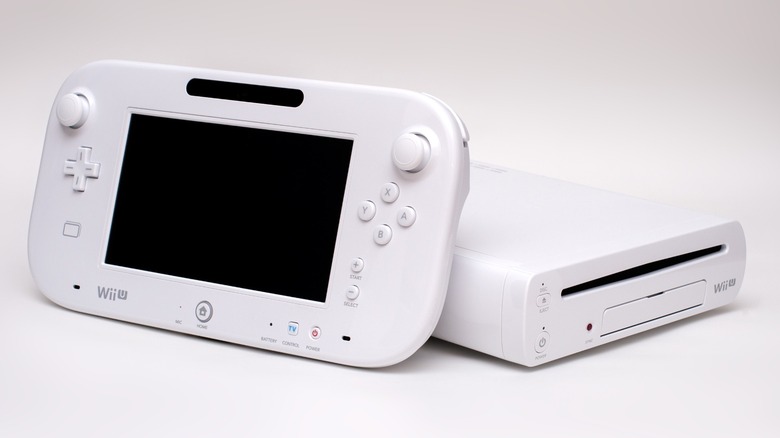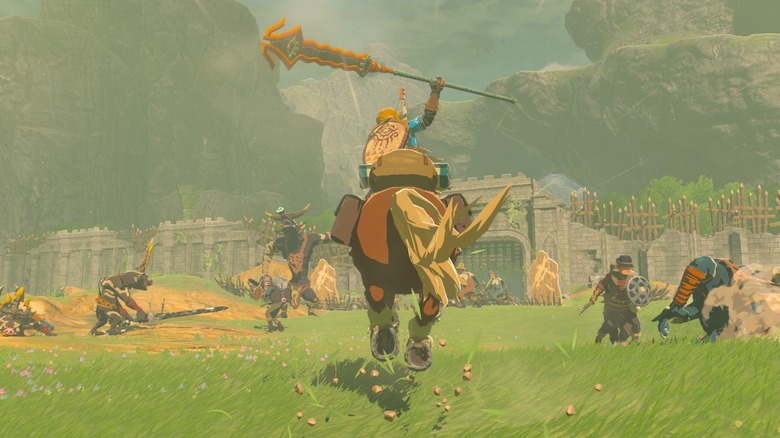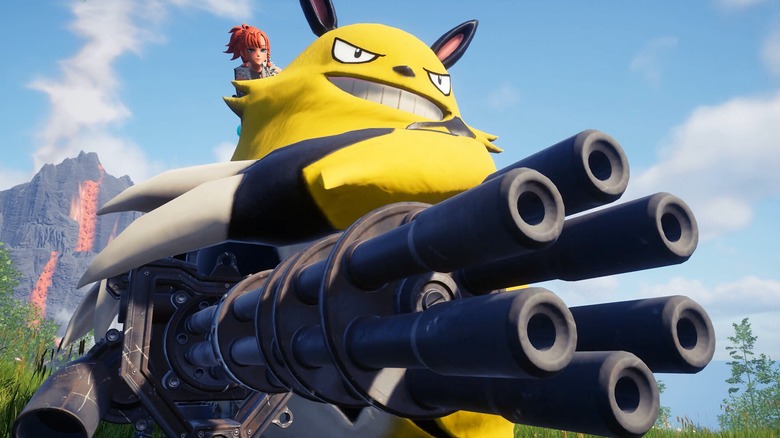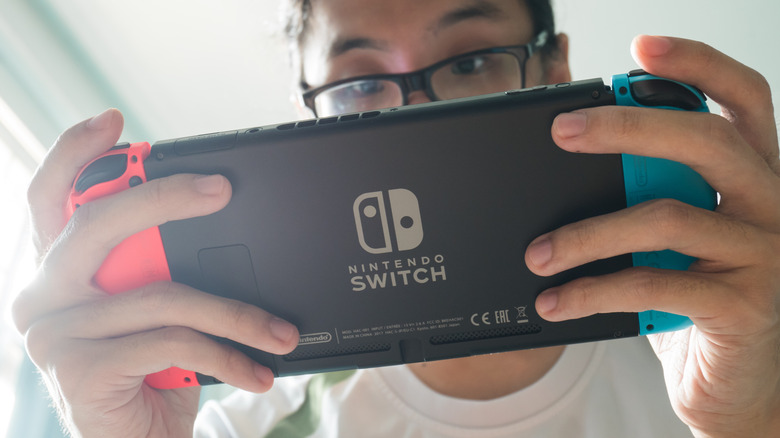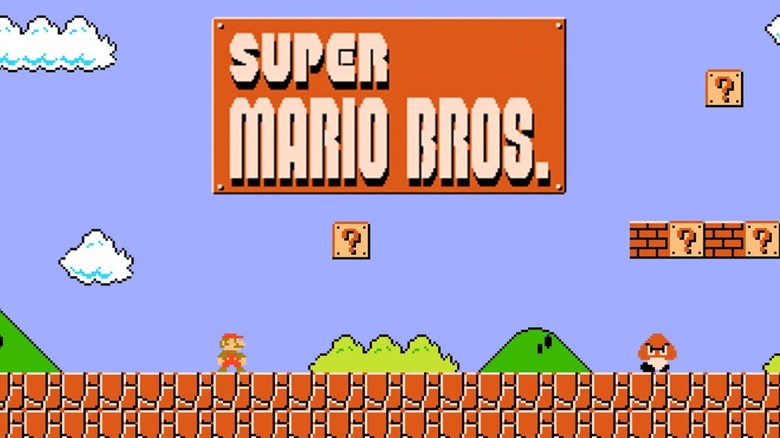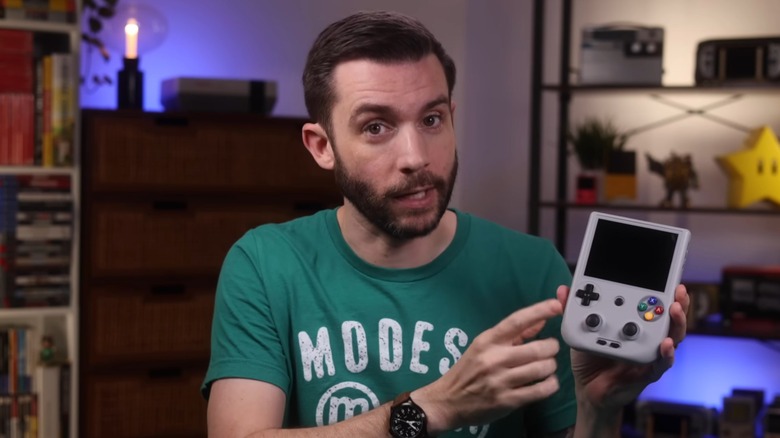The Shady Side Of Nintendo: Hidden Controversies & Questionable Incidents
Few names in the gaming world carry as much weight as Nintendo. The company behind immortal franchises such as Mario and Zelda rocketed to prominence in the 1980s with the NES, dominating the video game market into the 1990s. Nintendo no longer has such a stranglehold on the industry, of course, but it's still part of the Big Three of gaming alongside Sony and Microsoft.
Over the years, the company has admirably stuck to its guns and never abandoned the child- and family-friendly image that won it so many loyal fans in the 1980s and 1990s. As recently as 2013, Nintendo was still targeting its consoles to children and families, despite an industry-wide shift to grim and serious video game marketing — best exemplified by the "Mad World" trailer for "Gears of War" from 2006.
Behind the family-friendly image and lovable mascots, however, lays a corporation like any other: profit-minded, prone to the occasional misstep, and fiercely protective of its rights and intellectual property. Nintendo has antagonized more than a few groups and companies over the year. Here are some times Nintendo's behavior belied its friendly image.
Monopolistic practices
Nintendo was on top of the world in the 1980s and early 1990s, with a 65% market share in 1987. Former market leader Atari was a distant second, getting by with just 24% after the video game crash of 1983, and Nintendo's Japanese rival Sega was even further behind with a paltry 8%. Nintendo, by all accounts, had succeeded where Atari had failed, but this didn't come without some very restrictive practices.
The video game crash that brought Atari to its knees had its roots in market saturation: The absence of quality control on the Atari 2600 led to a glut of low-quality games that almost killed the medium. Seeking to avoid Atari's mistakes, Nintendo wanted games on the NES to be of high quality. It did so by tightly controlling manufacturing and licensing, charging developers royalties and manufacturing fees to release games on the system and limiting them to five games a year. It also implemented a hardware-based lockout chip called the 10NES, without which a game wouldn't boot.
Coupled with the console's popularity, these restrictions gave the company what most would now describe as a monopoly. Atari tried to stand up to Nintendo, reverse-engineering the lockout chip to bypass Nintendo's restrictions and release games without having to pay the licensing fees. The two corporations eventually went to court, with Atari suing Nintendo for antitrust violations and Nintendo counter-suing for the unauthorized cartridges. Nintendo emerged as the victor, and Atari continued its downward slide.
Donkey Kong's stolen code
"Donkey Kong" may be one of the most pivotal video games ever made — not least for being the video game debut of a certain Italian plumber named Mario — and one of the many franchises indelibly linked to Nintendo, but did you know that the company didn't have a direct hand in its development?
To be clear, "Donkey Kong" was Shigeru Miyamoto's brainchild, but he had nothing to do with the original code. Instead, Miyamoto hired a company called Ikegami Tsushinki Co., Ltd. to build it — which the company did within three months. However, the rest of the story isn't quite as straightforward. Ikegami Tsushinki was supposed to be the sole supplier for "Donkey Kong" PCBs, but Nintendo allegedly had an extra 80,000 PCBs built after the initial delivery without Ikegami Tsushinki's involvement.
This was bad enough to sour the relationship between the two companies, but things got worse. Miyamoto wanted to release a follow-up, but the fallout meant that the "Donkey Kong Jr." team had to reverse-engineer the original code without permission — a fact that developer Satoru Okada admitted in a 2022 interview with Japanese publication 4Gamer. Ikegami Tsushinki found out and sued Nintendo in 1983 for copyright infringement, seeking the modern equivalent of over $4 million in damages. The former won in 1990, although the full terms of the settlement have never been made public.
[Image by Microsiervos via Flickr | Cropped and scaled | CC BY 2.0]
Trying to take the video game rental industry down
If there's one thing you can say about Nintendo, it's that the corporation is fiercely protective of its IP, as we'll see later on in the list. In an often-overlooked incident with Blockbuster in 1989, the gaming giant tried to take down the rental chain, ostensibly for distributing photocopied manuals alongside rented video games.
The reality, of course, was a bit more serious: Nintendo didn't like video game rentals as a whole and wanted to put a stop to the practice. The copyright infringement angle seems to have been a way to get at Blockbuster given the lack of legal protection against rentals. The lawsuit was successful, to an extent: The two parties settled out of court, with Blockbuster agreeing not to distribute photocopied Nintendo manuals with rented games.
But while Nintendo may have won the battle, it didn't quite win the war. Despite the U.S. Congress finally passing the Computer Software Rental Amendments Act in late 1990 to limit software rentals — the result of a long five years of lobbying by the Software Publishers Association (SPA) — the act had one crucial exemption: video games. Blockbuster and other video rental chains were thus free to rent out video games. Nintendo had the last laugh, though: Blockbuster's empire crumbled in the 2010s, leaving only one outlet standing in Bend, Oregon.
Questionable 1990s ads
The 1990s were a different time and nowhere is that more evident than the world of video game advertising. While serious trailers dominate AAA gaming now (seriously, just watch a "God of War" trailer), 1990s publishers often opted for gross-out, distasteful, and arguably questionable advertising for their video games. And in spite of its cast of cutesy mascots, Nintendo was no exception.
We're particularly fond — if that's the right word — of the "Super Mario World 2" ad above, which not only features gross-out shots of a man devouring a ton of food, but tops it off with a shot of his guts blowing out from all the overeating, splattering staff and fellow diners in a sickly green goo, like a scene from "Monty Python's The Meaning of Life." The concept? That Nintendo had stuffed "Super Mario World 2" with new levels and content. This wasn't an outlier, either.
A "Kirby Dream Land" ad from later in the decade saw a cartoon Kirby suck a man up and spit him out as a floating ball of meat — not as gross, but still an odd choice.
At one point, Nintendo's even "quoted" god in. a print ad for the Nintendo 64, saying that the console was "the best thing I've ever seen." Sony got in that bandwagon too, with its infamous "It's more powerful than God" ad for the PlayStation. And speaking of the PlayStation...
Nintendo stabbed Sony in the back... and helped create the PlayStation
Nintendo's still one of the biggest video game companies out there, but we don't think it's too radical an assertion to say that its days near total market dominance are well and truly behind it. The stats back it up, too: As of 2022, Sony had 13% of the market, while Nintendo had 7%. That's still an impressive chunk of the pie, but there is a world where things could have been very different.
It may be hard to imagine now, but Sony wasn't initially interested in building a home console. Instead, the company would collaborate with Nintendo to create a Super NES CD drive add-on and a standalone "Play Station" console, the sole prototype of which is one of the rarest Nintendo consoles ever. The catch was that Sony would manufacture the disc media, potentially locking Nintendo out of a burgeoning market — and Nintendo wasn't happy about that.
Sony announced its Nintendo partnership at 1991's Computer Electronics Show, only for the latter to reveal, the next day, that it had struck a deal with Philips instead. In retaliation, Ken Kutaragi, the employee behind the CD add-on, convinced his superiors to go all-in on video games — giving birth to the Sony PlayStation, which debuted in 1994 and whose legacy continues with the newly launched PlayStation 5 Pro.
[Image by Mats Lindh via Wikimedia Commons | Cropped and scaled | CC BY 2.0]
The Switch's joy-con drift
By all accounts, the Nintendo Switch has been a roaring success. With more than 140 million units sold as of August 2024 and high-quality video games such as "The Legend of Zelda: Tears of the Kingdom" — which our own Rob Rich reviewed and loved — in its library, the console has helped Nintendo reestablish itself as one of the biggest names in gaming.
But despite its popularity and great games, the Nintendo Switch isn't perfect. One aspect in particular has come in for scrutiny from fans and industry commentators: the Joy-Cons. The Switch's joysticks have an infamous drift issue, detecting inputs the user hasn't actually made. The problem came to light in 2019 and became such a hot topic that Nintendo began offering free Joy-Con fixes and refunds. Nintendo's president Shuntaro Furukawa even publicly apologized for the issue in 2020, although that didn't stop owners from filing numerous class action lawsuits.
Fans who hoped that 2021's Nintendo Switch OLED would fix the issue were sorely disappointed, as the company maintained that Joy-Con drift was unavoidable. Fret not, however: Many alternative Nintendo Switch controllers without drift issues are available if you want to avoid this particular headache. Here's hoping the all-but-confirmed Nintendo Switch 2 overcomes this problem for good.
Child labor may have built the Wii U
If you kept up with tech news in the early 2010s, the name Foxconn probably rings a bell for all the wrong reasons. The Taiwanese supplier for tech giants such as Apple first began making headlines in 2010 for allegedly poor working conditions, with reports of suicides and physical abuse of workers. Things didn't improve much over the following years, with a mass brawl and strike in 2012 putting an even bigger spotlight on the working conditions in Foxconn's Chinese factories.
Sadly for Foxconn, things would get worse. In mid-October 2012, rights group China Labor Watch alleged that the company had employed underage interns on its assembly lines — some of which were building the Wii U. While Western reports mostly focused on iPhone 5 assembly lines, Chinese site Games QQ specifically mentioned the Wii U as being one of the products built with underage labor; the site's reporter quoted a factory worker who that "the product being rushed ... was the Wii U."
Nintendo only admitted to "investigating" the matter in a statement to Kotaku, so it's likely we'll never know for sure. The Wii U turned out to be something of a miss for Nintendo, but maybe that was a good thing for company's legacy.
[Image by Takimata via Wikimedia Commons | Cropped and scaled | CC BY-SA 3.0]
Protecting itself or stifling creativity?
Nintendo's protective attitude to its intellectual property doesn't extend to just the finished products. The company also has a wide range of patents — or attempted patents — on what seem to be basic gaming concepts, such as a "The Legend of Zelda: Tears of the Kingdom"-related patent that involves a character sitting on a moving object, and the interaction between the two entities.
Of course, Nintendo's patent goes into more specifics than that, with Japanese blogger naoya2k outlining that it specifically refers to a setup where a character — Link — moves together with the object, with both traveling at the same speed (versus the character being static on top of the object). Whether this is distinct enough from other ways that games handled character-object interactions in the past is up in the air, but Nintendo clearly thinks so. Somewhat more contentiously, Nintendo also attempted to patent "Tears of the Kingdom"'s fast travel loading screen, leading to accusations that the company intends to gatekeep basic gameplay elements.
That said, Nintendo seems within its rights to do so: Some legal experts have argued that the patents are worded specifically to only cover Nintendo's use cases. However, the problem is that Nintendo seems all too happy to use these allegedly specific patents to go after other companies, as we'll see next.
Nintendo versus Palworld
Pocketpair's "Palworld" was a huge hit when it launched in Early Access at the start of 2024, immediately hitting the top of Steam's sales charts and hitting an impressive 850,000 concurrent players within days of launch. The similarities of "Palworld" to the Pokémon games were apparent from the get-go, and the game was often boiled down — perhaps unfairly — to "Pokémon with guns."
Despite its similarities to Nintendo's monster-catching cash cow, Palworld seemed to have escaped Nintendo's often trigger-happy legal team, surviving its first six months without any firm legal action. That changed in September 2024, when the Japanese corporation formally announced that it was suing PocketPair for infringing on multiple patents. Nintendo didn't outline the specific patents "Palworld" allegedly violated, but it was widely believed that the game's Pal Spheres, which worked almost identically to PokéBalls, were what Nintendo had its sights on.
We're not legal experts, and thus can't say much about the strength or validity of Nintendo's claims. PC Gamer's interview with video game patent lawyer Kirk Sigmon is well worth reading on the matter — of note is his opinion that Nintendo's patents wouldn't hold up in the U.S., describing them as "pretty weak." Nintendo may yet win the legal battle, but as some journalists have pointed out, it's not a good look for the company even if it does.
The war on Switch emulation
Nintendo isn't a fan of emulation: Its old corporate FAQ didn't mince words, essentially calling all emulation "piracy." Despite that, the company historically avoided going after emulators, but that all changed in 2024. It all started with the popular Nintendo Switch emulator Yuzu, which Nintendo took issue with for allegedly facilitating piracy. Nintendo went all out, demanding a permanent injunction, control over Yuzu's social media and URLs, the seizure and destruction of the dev team's hard drives, and money in damages.
The developers caved, agreeing to Nintendo's demands to stop work on the emulator and hand everything over to the corporation. Nintendo also took down more than 8,500 Yuzu forks on Github in one fell swoop a few months later, showing it meant business. Yuzu competitor Ryujinx was still going strong, but not for long. Nintendo contacted the emulator's lead developer in October 2024, offering a deal to stop developing the emulator and remove it from the internet. The developer, gdkchan, agreed.
While we're not advocates of piracy here at SlashGear, the fact is that emulation isn't illegal, and Nintendo's attacks set a worrying precedent. Could Yuzu or Ryujinx have fought Nintendo off? Possibly. But, as lawyer Jon Loiterman told Ars Technica, fighting Nintendo's case in court would have taken a lot of money — something emulator developers probably don't have.
Nintendo may have sold fans a pirated ROM
For all of Nintendo's bluster about piracy, the company may have sold its fans a pirated ROM on the Wii Virtual Console all the way back in the late 2010s. If you're unfamiliar with the Virtual Console, it was a service that allowed you to play classic Nintendo games from older consoles on the Wii. One such game available during the Wii's heyday was "Super Mario Bros.," the company's all-time classic platformer (and one of the most expensive video games ever sold).
In an episode of Eurogamer's "Here's a Thing" series, Chris Bratt found that "Super Mario Bros." on the Virtual Console showed signs of having been a ROM sourced from the internet. The smoking gun was a .NES header in the code, which would have only been necessary for emulation. Bratt shared the findings with the iNES emulator developer, Marat Fayzullin, who confirmed that the Virtual Console version of "Super Mario Bros." matched other illegally distributed versions of the game available on the internet. Nintendo, of course, declined to comment.
A troubled relationship with content creators and fans
We've covered quite a few groups and entities that Nintendo has antagonized in some way, but we'll close off our list with what feels like the most tragic victim of Nintendo's legal team: content creators.
Nintendo has a long history of not necessarily seeing eye-to-eye with fans and creators, stretching back into the early 2010s — see, for example, its 2013 takedown of Let's Plays on YouTube — but the past few years have seen a notable escalation in Nintendo's behavior. There's YouTuber PointCrow, who felt the wrath of Nintendo's DMCA strikes on videos showcasing a "Legend of Zelda: Breath of the Wild" multiplayer mod. Fans suffered too, with Nintendo shutting down a COVID-19 lockdown-era "Super Smash Bros. Melee" tournament for using emulation and an online mod, at a time when in-person tournaments were a no-go.
The most notable recent example of Nintendo's seemingly hostile relationship with content creators is likely the case of YouTuber Retro Game Corps (RGC), whose channel focuses primarily on the emulation of old video games. Nintendo went for the jugular, making DMCA claims on his videos discussing Nintendo emulation, even for years-old consoles like the Wii U — and nearly costing RGC his YouTube channel. This action conveniently came after Nintendo updated its content guidelines requesting creators not portray the company's IPs in an "unlawful, infringing, [and] inappropriate" manner. Nintendo, of course, decides what that looks like.
